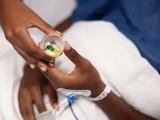A survey out today from the European Centre for Disease Prevention and Control (ECDC) indicates that European healthcare workers, for the most part, have a high level of knowledge about appropriate antibiotic use and the role that inappropriate prescribing plays in antibiotic resistance. But important knowledge gaps remain.
In the survey of more than 18,000 healthcare workers in 30 European Union/European Economic Activity (EU/EEA) countries, 89% agreed that there was a connection between their prescribing of antibiotics and the emergence of antibiotic-resistant bacteria, and 97% to 98% agreed that antibiotics are not effective against viruses or colds and are associated with side effects.
But less than 60% of the respondents were able to answer seven true/false knowledge questions about antibiotics correctly. And only 58% agreed that they had a key role to play in helping control antibiotic resistance.
The survey, released in conjunction with European Antibiotic Awareness Day, was accompanied by reports on EU/EEA antibiotic consumption and resistance levels in 2018.
More education, resources needed
Overall, the online survey included 43 questions aimed at getting a better understanding of European healthcare workers' knowledge, attitudes, and behaviors when it comes to antibiotic use and resistance. Nearly half of the respondents (49%) work in hospitals, with other participants representing primary care settings (22%), pharmacies (10%), and long-term care facilities (6%). The answers will be used for future policy and education interventions.
The perceived capability regarding antibiotic use was high across the board among the respondents. Ninety-six percent said they knew what antibiotic resistance is, 80% said they had sufficient knowledge on using antibiotics correctly, and 86% said they know what information to give individuals about prudent use of antibiotics.
And when asked whether seven statements about antibiotic use—such as "antibiotics are effective against viruses"— were true or false, the vast majority answered correctly. The statement with the lowest proportion of correct answers (75%) was "Every person treated with antibiotics is at increased risk of antibiotic-resistant infection."
But overall, only 58% of respondents gave correct answers on all seven key knowledge questions about antibiotics, and the percentage of healthcare workers who answered correctly ranged widely across countries, from 40% in Estonia to 73% in Croatia and Ireland.
Survey responses also suggested some divergence between knowledge and practice. Thirty-one percent of prescribers said that they would have preferred not to use an antibiotic at least once in the week prior to completing the survey, but did so anyway. And 43% said they had prescribed antibiotic in the prior week because they feared patient deterioration or complications.
Other areas of concern emerged from responses to questions about national initiatives and campaigns. Only 41% agreed that there had been good promotion of responsible antibiotic use and information about antibiotic resistance in their country, and only 27% agreed that their country's national campaign had been effective in reducing unnecessary antibiotic use. Slightly more than half of respondents were unsure whether their country had a national antibiotic resistance action plan in place.
In addition, 20% of healthcare workers said they did not give advice to patients on prudent antibiotic use in the previous week, and 51% said they did not give out resources. Most attributed this to lack of resources and lack of time with patients. Twenty-five percent said they did not have easy access to guidance on proper infection management.
ECDC officials say the results highlight the areas where more work is needed.
"With our study results, we now have a wealth of data about key issues concerning healthcare workers and antibiotic resistance, across all EU/EEA countries, all healthcare professions and healthcare settings," ECDC Director Andrea Ammon, MD, said in a press release. "These can be used when developing locally adapted interventions to ensure prudent use of antibiotics, focused on changing behaviour and practice among healthcare workers."
Antibiotic use and resistance in Europe
Meantime, a summary of the latest data on invasive isolates reported to the European Antimicrobial Resistance Surveillance Network (EARS-Net) shows that antibiotic resistance remains a significant health problem on the continent, with high variability in resistance seen across EU/EEA countries.
According to the 2018 EARS-Net report, more than half of the Escherichia coli isolates (58.3%) and more than a third of the Klebsiella pneumoniae isolates (37.2%) were resistant to at least one antibiotic class under regular surveillance, with combined resistance to multiple antibiotics classes more frequent in K pneumoniae (19.6%) than in E coli (6.2%). Although rare in E coli, carbapenem resistance percentages were above 10% for K pneumoniae in several countries, and were even higher for Pseudomonas aeruginosa and Acinetobacter species.
Trend analysis showed that for most gram-negative-bacteria antibiotic class combinations, changes in resistance percentages from 2015 through 2018 were moderate, with resistance remaining at previously high levels. Among gram-positive bacteria, the report found that the percentage of methicillin-resistant Staphylococcus aureus (MRSA) isolates continued to decline, falling from 19.0% in 2015 to 16.4% in 2018, while the percentage of vancomycin-resistant Enterococcus faecium isolates rose sharply, from 10.5% in 2015 to 17.3% in 2018.
As in previous years, variations in antibiotic resistance levels continued to follow an established geographic pattern, with countries in northern Europe reporting lower resistance percentages than those in southern and eastern Europe. Those variations tend to match north-to-south variations in antibiotic consumption in Europe.
"The high levels of AMR [antimicrobial resistance] for several important bacterial species-antimicrobial group combinations reported to EARS-Net for 2018 show that AMR remains a serious challenge in the EU/EEA," the report states. "Despite the political prioritisation of AMR as a threat to public health and the availability of evidence-based guidance for antimicrobial stewardship, adequate microbiological capacity and infection prevention and control, it is clear that public health action to tackle the situation remains insufficient."
The report from the European Surveillance of Antimicrobial Consumption Network (ESAC-Net), however, indicated that some European countries are having success in reducing antibiotic use.
In 2018, the average total consumption of antibiotics for systemic use in the community/primary care sector was 18.4 defined daily doses (DDD) per 1,000 inhabitants per day. While no statistically significant change in consumption was observed for the EU/EEA overall from 2009 through 2018, nine countries saw statistically significant declining trends over the period (compared with four countries in 2016).
In the hospital sector, the average consumption of antibiotics for systemic use was 1.8 DDD per 1,000 inhabitants per day, with no change overall in the EU/EEA from 2009 through 2018 but decreasing trends observed in five countries and increasing trends in six countries. Four countries reported increases in hospital use of carbapenems and polymyxins—antibiotics reserved for the most serious, multidrug-resistant infections.
See also:
Nov 18 ECDC survey
Nov 18 ECDC press release
Nov 18 EARS-Net 2018 report
Nov 18 ESAC-Net 2018 report























